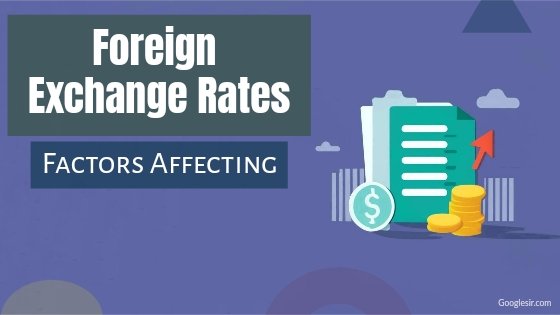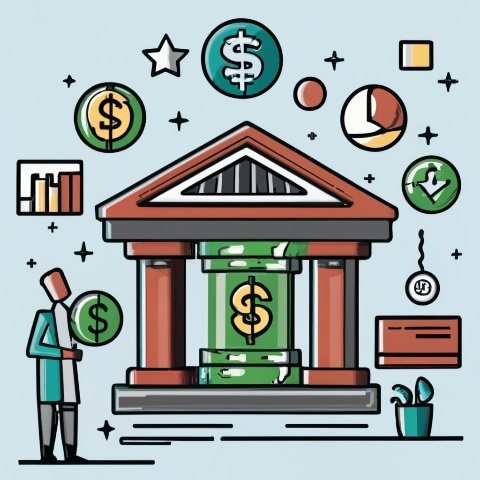Foreign exchange rates, often abbreviated as Forex or FX rates, play a pivotal role in the global economy. These rates determine the value of one currency relative to another, impacting international trade, investment, and financial markets. Understanding the multitude of factors that influence foreign exchange rates is essential for experts in finance, economics, and international business.

Foreign exchange rates represent the relative value of one currency compared to another. They are determined in the foreign exchange market, where currencies are bought and sold. These rates are typically expressed as currency pairs, with one currency being the base currency, and the other the quote currency.
For example, in the EUR/USD pair, the euro (EUR) is the base currency, and the US dollar (USD) is the quote currency.
The foreign exchange market is one of the largest and most liquid financial markets globally, with a daily trading volume that surpasses $6 trillion. It serves various functions, including facilitating international trade, hedging currency risk, and providing speculative opportunities for traders and investors.
What are the Factors Influencing Foreign Exchange Rates?
The following are the key factors that affect foreign exchange rates and unravel their intricate connections to the currency market.
1. Interest Rates:
Interest rates set by a country’s central bank are a cornerstone of the foreign exchange market. These rates determine the return on investments denominated in a particular currency.
Higher interest rates offer the potential for greater returns on investments in that currency, attracting foreign capital inflows. As investors seek higher yields, they demand more of the currency with higher interest rates, thus increasing its value.
Conversely, when a central bank lowers interest rates, it becomes less appealing for investors to hold assets in that currency, as they can find better returns elsewhere. This can lead to a decrease in demand for the currency, causing its value to depreciate. Therefore, central bank decisions regarding interest rates are closely watched by traders and investors, as they can significantly impact exchange rates.
2. Inflation Rates:
Inflation rates reflect the rate at which the purchasing power of a currency erodes over time.
Currencies in countries with low inflation rates tend to appreciate because their purchasing power remains relatively stable, making them attractive to investors. In contrast, currencies in countries with high inflation rates may depreciate as their value is eroded more quickly.
High inflation can lead to a decrease in the real return on investments in a particular currency, as the nominal returns are eroded by rising prices. This can deter foreign investors and reduce demand for the currency. Therefore, keeping inflation in check is essential for maintaining a stable currency value.
3. Economic Performance:
A country’s overall economic performance has a profound impact on its currency’s value. A strong economy, characterized by robust GDP growth, low unemployment, and positive economic indicators, fosters investor confidence.
As a result, foreign investors may be more inclined to invest in assets denominated in that currency, driving up its value.
Conversely, economic downturns, high unemployment rates, or instability in economic indicators can undermine confidence in a country’s economy. This may deter foreign investment and lead to a depreciation of the currency. Economic performance is closely scrutinized by experts and investors as a primary indicator of a currency’s strength or weakness.
4. Political Stability:
Political stability is a fundamental factor influencing foreign exchange rates. Countries with stable political environments tend to attract foreign investment and maintain stronger currencies.
Political uncertainty, government instability, or geopolitical conflicts can have the opposite effect, leading to currency depreciation.
Investors often view political stability as a sign of economic stability, as political turmoil can disrupt economic activities and deter foreign capital. Consequently, political events and developments are closely monitored by experts in the field, as they can lead to significant fluctuations in currency values.
5. Speculation:
The foreign exchange market is heavily influenced by speculation. Traders and investors engage in speculative activities by buying and selling currencies based on their expectations of future price movements. These speculators can impact exchange rates, even if their actions do not align with fundamental economic factors.
Speculative trading can lead to short-term volatility and abrupt currency movements. Traders may use various tools and strategies, such as technical analysis and sentiment analysis, to make predictions about future exchange rate movements.
While speculation can introduce unpredictability into the market, it also provides liquidity and trading opportunities for market participants.
6. Trade Balances:
A country’s trade balance, which measures the difference between its exports and imports, is a crucial factor influencing foreign exchange rates.
When a country exports more goods and services than it imports, it runs a trade surplus. In this scenario, foreign buyers need to acquire the country’s currency to pay for its exports, increasing demand for the currency and causing it to appreciate.
Conversely, when a country imports more than it exports, it experiences a trade deficit. This can lead to a decrease in demand for the currency, as the country needs to purchase foreign currencies to pay for its imports. Consequently, trade balances are closely monitored by experts and policymakers, as they can have a direct impact on a country’s currency value and overall economic health.
7. Government Debt:
The level of government debt in a country can have a substantial impact on its currency’s value. High levels of government debt can be perceived as a risk, as they may raise concerns about a country’s ability to meet its financial obligations.
To attract investors, governments may need to offer higher interest rates on their bonds, which can lead to currency depreciation.
If a country’s government debt is considered unsustainable, it can result in a loss of confidence among investors and an outflow of capital, further weakening the currency. Investors closely monitor a country’s fiscal health, making government debt levels a critical factor influencing foreign exchange rates.
8. Current Account Balance:
The current account balance is a broad measure that includes trade in goods and services, income from investments, and transfers.

A country with a current account surplus (exports and income exceed imports and transfers) tends to have a stronger currency. This surplus indicates that the country is a net creditor to the rest of the world, attracting foreign investment and demand for its currency.
Conversely, a current account deficit (imports and transfers exceed exports and income) can put downward pressure on the currency.
It signifies that the country is borrowing from abroad to finance its spending, potentially leading to a weaker currency. The current account balance is a crucial indicator of a country’s economic health and its impact on exchange rates.
9. Market Sentiment:
Market sentiment is often driven by news events, economic data releases, and geopolitical developments.
Positive news, such as strong economic growth or successful policy initiatives, can lead to a surge in demand for a currency. Conversely, negative news, such as economic downturns or geopolitical tensions, can result in a rapid depreciation.
Traders and investors closely monitor sentiment indicators and news sources to gauge market sentiment and make informed trading decisions. The emotional and psychological factors driving market sentiment can cause short-term fluctuations in exchange rates, even if they do not align with fundamental economic factors.
10. Central Bank Interventions:
Central banks have the authority to intervene in the foreign exchange market to stabilize or influence their currency’s value. They can buy or sell their own currency in the open market or employ various monetary policy tools to achieve their desired exchange rate.
Central bank interventions can be particularly effective in the short term. For instance, a central bank may intervene to prevent excessive currency appreciation that could harm its export competitiveness.
While interventions can influence exchange rates, they are not always sustainable over the long term and may require significant reserves.
11. Currency Pegs and Bands:
Some countries choose to peg their currency to a stable foreign currency or maintain it within a predetermined exchange rate band.
In these cases, the central bank actively intervenes in the foreign exchange market to keep the currency’s value within the specified range.
Deviations from the peg or band can trigger central bank interventions or policy adjustments. For example, if a country’s currency approaches the upper limit of a band, the central bank may sell its currency to bring it back within the desired range. Currency pegs and bands are tools used by some countries to maintain exchange rate stability.
12. Market Liquidity:
Market liquidity refers to the ease with which assets can be bought or sold without significantly affecting their prices. Liquidity is a crucial factor in the foreign exchange market.
Major currency pairs, such as EUR/USD and USD/JPY, tend to be more liquid than exotic pairs because they have higher trading volumes and more market participants.
In highly liquid markets, it is easier to execute large trades without causing significant price movements. In contrast, illiquid markets may experience more substantial price swings with even relatively small trades. Liquidity considerations are vital for traders and investors when selecting currency pairs to trade and managing risk.
13. Capital Flows:
Capital flows encompass foreign direct investment (FDI), portfolio investment, and other financial transactions between countries. These flows can significantly influence exchange rates.
A country that attracts substantial foreign investment, whether through FDI or portfolio investment, tends to experience an appreciation of its currency. The demand for the local currency rises as foreign investors seek assets in that country, increasing its value.
Conversely, capital flight or a sudden outflow of funds can lead to currency depreciation. Factors such as changes in investor sentiment, economic conditions, or geopolitical events can trigger capital flight. Understanding the flow of capital and its impact on the foreign exchange market is crucial for experts in the field.
14. Economic Indicators:
Economic indicators, including GDP growth, employment figures, and consumer confidence, provide valuable insights into a country’s economic health.
Traders, investors, and policymakers closely monitor these indicators as they can significantly impact currency values. When economic indicators deviate significantly from expectations, they can trigger sharp movements in exchange rates.
For example, strong GDP growth and low unemployment rates can boost investor confidence, potentially leading to currency appreciation. Conversely, disappointing economic data can have the opposite effect, causing a currency to depreciate. Experts analyze these indicators to gauge the overall economic performance and make predictions about future currency movements.
15. Natural Disasters:
Natural disasters, such as earthquakes, hurricanes, tsunamis, or severe weather events, can disrupt a country’s economy and infrastructure. The extent of the impact depends on the severity of the disaster and the country’s preparedness and resilience.

Natural disasters can lead to significant economic losses, increased government spending on recovery efforts, and disruptions to trade and production. These consequences can result in currency depreciation as investors and traders react to the economic uncertainty and potential long-term damage.
16. Technological Advancements:
Advancements in technology, particularly in the financial industry, can have an impact on foreign exchange rates.
High-frequency trading (HFT) algorithms, for example, can execute trades at speeds that human traders cannot match. This high-speed trading can lead to rapid price movements and short-term volatility in currency markets.
Additionally, technological innovations in data analysis and trading platforms have made it easier for market participants to access and analyze information, potentially influencing trading decisions and exchange rate movements.
17. Exchange Rate Expectations:
Exchange rate expectations can become self-fulfilling prophecies. If market participants collectively expect a currency to appreciate, they may increase their demand for it, causing it to appreciate in reality. Conversely, expectations of depreciation can lead to selling pressure, resulting in a currency’s decline.
Exchange rate expectations are influenced by a wide range of factors, including economic data releases, central bank communications, geopolitical events, and market sentiment.
Traders and investors closely monitor these expectations and attempt to anticipate future currency movements based on them.
Conclusion:
Foreign exchange rates are influenced by a myriad of factors. From interest rates, inflation, and economic performance to political stability, market sentiment, and technological advancements, these elements collectively shape currency values.
For experts in finance, economics, and international business, understanding these factors is paramount. These factors not only impact currency traders and investors but also have implications for governments, central banks, multinational corporations, and policymakers worldwide.
As the global economy continues to evolve, the foreign exchange market remains a central player. Those who grasp the intricacies of these factors are better positioned to navigate the dynamic world of foreign exchange rates, make informed decisions, manage risk effectively, and contribute to global economic stability and growth.

